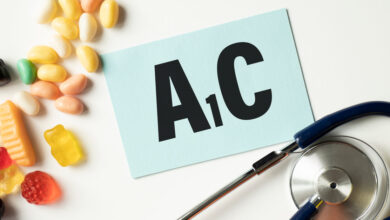What is Type 2 Diabetes?

Type 2 Diabetes is a condition where the body has an impaired ability to produce or respond to the hormone insulin, resulting in an increased level of glucose in the blood.
There are various types of diabetes, with the most common being Type 2 diabetes, Type 1 diabetes, and gestational diabetes. Today, type 2 diabetes is the most common type, it accounts for 85-90% of all diagnosed diabetes.
Most of the carbohydrate food we eat is turned into the simplest molecule of fuel called glucose which is used by cells of the body as a source of energy. The beta cells of the pancreas make insulin which acts as an usher to open cell “doors” and help glucose get into the cells of our bodies.
When you have diabetes, there are either not enough of these beta cells in the pancreas leading to low levels of insulin, or there are enough beta cells but they don’t make enough insulin or the body resists the actions of the insulin and can’t use its own insulin as well as it should. Each of these can lead to a relative insulin deficiency.
This means that you do not have enough insulin to keep your blood glucose in the normal range. If you had enough insulin your blood glucose would be normal and you would not have diabetes.
Can Type 2 Diabetes be Cured or Reversed?
There is no known cure for type 2 diabetes. But it can be controlled. And in some cases, type 2 diabetes can go into remission (reversed). When diabetes is in remission, you have no signs or symptoms of it. But your risk of relapse is higher than normal. That’s why you need to make the same daily healthy choices that you do for active type 2 diabetes.
For some people, a diabetes-healthy lifestyle is enough to control their blood sugar levels. That means losing weight if you are overweight, eating healthy foods, and being more active. But most people with type 2 diabetes also need to take one or more medicines or insulin. Of those people who don’t need diabetes medicine, some find that their diabetes does “reverse” with weight control, diabetes-healthy eating, and exercise. Their bodies are still able to make and use insulin, and their blood sugar levels go back to normal. Their diabetes is in remission. However, weight gain and inactivity can open the door and allow the blood glucose levels to again rise to the levels consistent with the emergence of diabetes.
When Should I See My Doctor?
Both type 2 and type 1 diabetes require frequent review. The person living with diabetes needs to be involved in their own care on a daily basis. What this involves will vary from person to person depending on their individual circumstances (their age, their HbA1c, Blood pressure, cholesterol levels, and complications at a minimum). The same applies to how often you involve your doctor and other diabetes team members. At a minimum, its best you see your doctor every 3 to 4 months for a review of how you are managing with and controlling your diabetes. Feedback and support remind you that you are not on this journey alone. Transforming how you live with and manage your diabetes is a team effort.
What are the Symptoms of Diabetes?
Most people with type 2 diabetes have no symptoms at all. This is an important fact to remember as it is the reason many cases remain undiagnosed for years. Due to this late diagnosis, many complications occur during the undiagnosed period and complications due to diabetes are already present when an initial diagnosis is made. However, symptoms do occur when glucose either gets into the wrong cells or organs or does not get into the cells at all.
Examples of when glucose is in the wrong cells include blurred vision and pins and needles in your hands and feet. Common symptoms that occur in diabetes due to glucose not entering the right cells include Frequent urination, Hunger, Tiredness, Weight loss, Dry and itchy skin to name a few.
How is Type 2 Diabetes Diagnosed?
There are several ways to diagnose diabetes each of which usually needs to be repeated on an alternate day to confirm the diagnosis of diabetes – After all, this can be a life-changing diagnosis and we need to be certain of the diagnosis.
Testing should be carried out in a health care setting – either in your doctors’ rooms or at the local pathology collection centre. If your doctor determines that your blood glucose level is elevated, or if you have classic symptoms of high blood glucose in addition to one positive test, your doctor may not require a second test to diagnose diabetes.
The following summary explains the levels for diagnosis:
- A fasting blood glucose above 7 mmol and another blood glucose level after food above 11.1 mmol OR
- A HbA1c above 6.5% OR
- Abnormal blood glucose levels found on an oral glucose tolerance test (OGTT) – now done far less often than 5 years ago
What is the Difference Between Type 1, Type 2 and Gestational Diabetes?
Type 1 diabetes
Type 1 diabetes is an auto immune disease leading to destruction of beta cells in the pancreas leading to absolute insulin deficiency with resulting increase in blood glucose level (hyperglycaemia) People with type 1 diabetes require insulin for survival. Usually, this form of diabetes presents in children and young adults. It is associated with the classical symptoms of thirst and excess urination (polyuria), weight loss and tiredness. When we do a blood glucose test these people will have a high random blood glucose level (BGL).
Type 1 diabetes accounts for about 10% of all diagnosed diabetes. 25 to 50% of cases may occur after age 20 but before age 40.
Type 2 Diabetes
Type 2 diabetes is a metabolic disorder characterised by insulin resistance with relative insulin deficiency or insufficiency leading to high blood glucose. Most people with type 2 diabetes do not require insulin for survival, unlike type 1 diabetes an auto immune destruction of beta cells does not occur. At the time of diagnosis most people with type 2 diabetes have lost 50% of their pancreatic beta cell function – they are already partially insulin deficient. Type 2 diabetes accounts for approximately 80 to 85% of all the diagnosed diabetes
Gestational diabetes (GDM)
Gestational diabetes (GDM) is a form of diabetes that occurs in pregnancy. It is seen 1 in 7 pregnancies and there is active surveillance in place in the antenatal care process for early detection and diagnosis to minimise the impact on the baby and mother. Generally managed with diet, sometimes tablets or insulin are needed. GDM usually resolves after the baby arrives, however there is an associated increased risk of type 2 diabetes in later life.
Can Type 2 Diabetes be Prevented?
The short answer is yes! The Diabetes Prevention Program (DPP), which started in 1998 looked at whether the DPP Lifestyle Change Program or taking metformin would delay or prevent type 2 diabetes. The results of this study changed the way we approach type 2 diabetes prevention worldwide. The DPP showed that people who are at high risk for type 2 diabetes can prevent or delay the disease by losing a modest amount of weight through lifestyle changes (dietary changes and increased physical activity). Taking metformin, a safe and effective generic medicine to treat diabetes, was also found to prevent the disease, though to a lesser degree.
After about 3 years, the DPP showed those in the Lifestyle Change lowered their chances of developing type 2 diabetes by 58 percent compared with those who took a placebo (a pill without medicine). The Program worked particularly well for the 60 and older, lowering their chances of developing type 2 diabetes by 71 percent.
Those in the study who took metformin lowered their chances of developing type 2 diabetes by 31 percent compared with those who took a placebo. Metformin was most effective in women with a history of gestational diabetes, and in people between the ages of 25 and 44, and in people with obesity who had a body mass index of 35 or higher.
Interestingly, from the DPP many countries developed diabetes risk tools.
These tools look at fixed risk factors (age, gender, family history, ethnicity and whether you have ever had an elevated blood glucose level) and modifiable risk factors (Blood pressure, waist measurement, activity, smoking history, fruit and vegetable intake). From these tools your 5-year risk of developing diabetes is calculated. From there, increasing activity, losing weight especially from your waist, and selecting food that is more nutritional, yet portion controlled will all reduce your risk and prevent or delay the development of type 2 diabetes by up to 15 years.
What are the Complications of Type 2 Diabetes?
There is a common misconception amongst patients that Type 2 diabetes is a mild disease – “a touch of sugar”. At the time of diagnosis complications are present in up to 50% of people. Type 2 diabetes is a progressive disorder. The risk of developing complications increases with the duration of diabetes and poor diabetes control. Good diabetes control can reduce the incidence of complications but may not entirely eradicate them.
The major complications of diabetes are caused by vascular (blood vessel) disease, either macro (large vessel) vascular or micro (small vessel) vascular. Macro vascular disease is the predominant cause of death in type 2 diabetes.
Macro vascular complications include:
- Cerebrovascular disease – strokes.
- Cardiovascular disease – heart attacks, angina,
- Peripheral vascular disease – poor circulation in legs and neck arteries
Micro vascular complications include:
- Retinopathy- the blood vessels in the eyes bleed. This bleeding can lead to blindness.
- Nephropathy – Too much glucose in your blood is very hard on your kidneys. After a number of years, high blood glucose can cause the kidneys to stop working.
- Neuropathy – autonomic and peripheral – Over time, high blood glucose can harm the nerves in your body. Nerve damage can cause you to lose the feeling in your feet or to have painful, burning feet. It can also cause pain in your legs, arms, or hands or cause problems with eating, going to the bathroom, or having sex.
Other non-vascular complications include:
- Dermopathy – Skin infections
- Dental and periodontal disease
- Cataracts
Many complications are preventable. Studies have shown that intensive treatment with reduction in HbA1c in the first ten years after diagnosis decreased the frequency of complications in people with Type 2 diabetes by up to 40%.
How is Type 2 Diabetes Managed?
Managing type 2 diabetes is like building a house. You as an individual need to be involved in every step, understanding that you have to make decisions that will impact on how your home will look and feel.
You need a good foundation upon which to build. This foundation is your lifestyle – the food you eat and the activity you do. Approximately 16% of people with type 2 diabetes are managed with diet and exercise alone and do not progress to needing medications.
On the foundation of lifestyle, are added medications to control blood glucose, blood pressure, and cholesterol and for managing the impact of complications.
Medications for lowering blood glucose are numerous with oral and injectable formulations. They are all effective and are often used in combination to achieve lowering of blood glucose to levels that will help you achieve a HbA1c of less than 7%.
However, lifestyle and medications simply form the framework for managing diabetes. Regular reviews, with your doctor who will arrange pathology referrals, physical examination every 3 to 4 months and coordination of your diabetes team, will optimise how you manage your diabetes.



